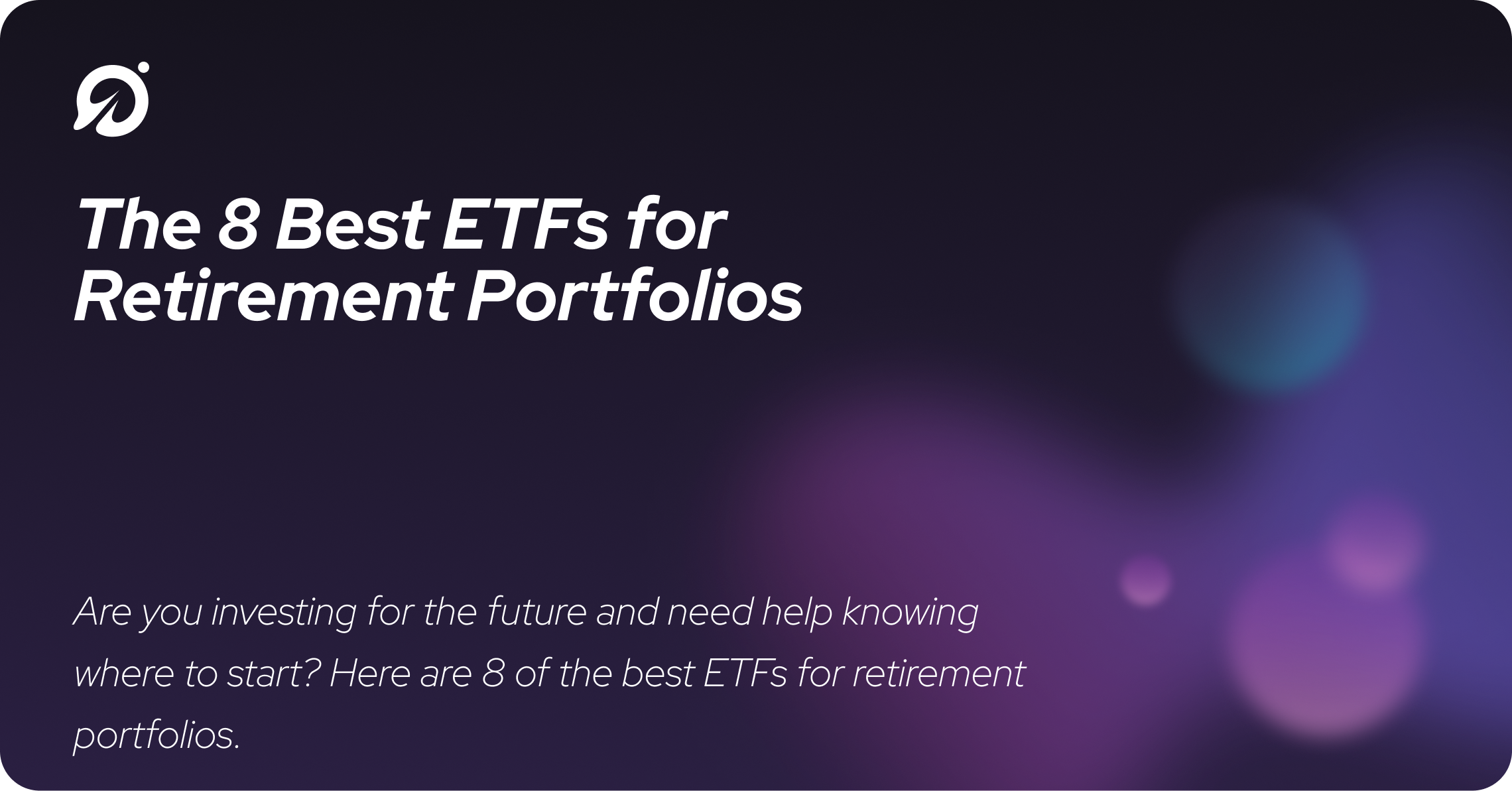The 8 Best ETFs for Retirement Portfolios
If you consider yourself an investor or simply an American with a 401k, consider investing in exchange-traded funds with low-expense ratios rather than mutual funds or bond funds.

Disclaimer: This is for informational purposes and is not meant to serve as financial or investing advice.
ETFs function like index mutual funds but come with lower costs, greater flexibility, and liquidity. ETFs have more transparent fee structures, can be traded more granularly, and boasts much less overhead. That means lower annual fees that may hinder your overall returns.
This is especially important for tho who are investing for their future and retirement. Regarding asset allocation, having a well-diversified portfolio and carefully chosen long-term securities like ETFs are imperative.
Outlined below are eight of the best ETFs for retirement portfolios.
1. SPDR Portfolio S&P 500 ETF (SPY ETF)
The exchange-traded fund (ETF), SPDR, is short for the Standard & Poor’s Depositary Receipt and is also known as the SPY ETF. It is one of the most popular funds that aims to track the S&P 500 (Standard & Poor’s 500 Index), comprised of 500 large-cap U.S. stocks.
The S&p 500 is considered one of the main benchmarks of the U.S. equity market and indicates the financial health and stability of the general economy.
What Are the Benefits of SPY ETF?
SPY is often regarded as the first index exchange-traded fund listed on the U.S. exchange and remains the most actively traded ETF to date. With this longevity, SPY has built a positive reputation in retirement portfolios.
As of October 2022, SPY has built up $340.8 billion in assets and pays out a dividend yield of 1.65% in distributions.
The price of the SPY ETF intends to follow at a 10% expense ratio to the S&P 500. So, if the S&P 500 index fund is priced at $5,000, SPY ETF shares will be priced at around $500.
How Can You Invest in SPY ETF?
SPY ETF is listed on the New York Stock Exchange’s Arca Exchange and is tradable on multiple brokerage platforms. Because ETF shares function similarly to stocks, investors can buy and sell SPY shares on their brokerage account throughout the market day, including selling them short.
2. Vanguard S&P 500 ETF (VOO)
The Vanguard S&P 500 ETF, also known as VOO, is a security fund that invests in the stocks of some of the largest companies in the U.S. today. VOO is an exchange-traded fund/ ETF that tracks the S&P 500 by owning all of the stocks within the S&P 500.
What Are the Benefits of VOO?
The VOO ETF is appealing to investors primarily because of its diversification in investment portfolios. The fund is heavily weighted in large-cap stocks, including information technology, healthcare, and consumer discretionary.
Large-cap stocks are high-quality, more stable, and hold a solid track record of profitability in retirement accounts as opposed to smaller individual stocks. These companies also tend to be dividend stocks, making for an excellent fixed-income source.
The Vanguard S&P 500 ETF offers low fees because it is not directly managed by a professional but instead because it mirrors the S&P 500’s index.
How Can You Invest in VOO?
You can invest in ETFs such as VOO in the same fashion as regular stocks. VOO can be purchased on major exchange platforms and brokerages during regular trading hours, including Fidelity and Schwab. If you have a financial advisor, they can invest in these securities on your behalf.
3. Vanguard Total Stock Market ETF (VTI)
The Vanguard Total Stock Market ETF (VTI) tracks the performance of the CRSP U.S. Total Market Index. The fund is a market-capitalization-weighted index that measures the stability of the U.S. equity market. It invests in small, mid, and large-cap companies, holding 3,900 stocks.
VTI’s top sector is technology, with its three top holdings being Microsoft, Apple, and Alphabet.
What Are the Benefits of VTI?
VTI has a low expense ratio of 0.03%, making it a low-cost way to gain exposure to the broader U.S. equity market.
The ETFs holdings comprise 3,900 stocks, which makes it a diversified security addition to an investment portfolio, especially for retirement portfolios.
This ETF is an open-ended fund issued by Vanguard and is considered a passive index fund with a low expense ratio. Low expense ratios are beneficial for long-term investing. Financial advisors advise it for ira accounts and retirement savings.
How Can You Invest in VTI?
You can invest in VTI on the New York Stock Exchange. Investors can purchase shares with no commission directly through Vanguard Brokerage Services.
4. Vanguard Total World Stock ETF (VT)
The Vanguard Total World Stock ETF, known as VT, tracks a market-cap-weighted index of global stocks covering 98% of the domestic and emerging market capitalization.
The fund uses a sampling approach to track the index. This means that it may not hold all the stocks in the index. Instead, it will store representative samples of the securities that resemble the complete index.
What Are the Benefits of VT?
VT holds a well-diversified, cap-weighted portfolio of developed and emerging market stocks.
This ETF is an open-ended fund with a low expense ratio of 0.07%. It also pays out dividends to shareholders, making it a good option for your investment strategy.
VT’s three top holdings are Apple, Microsoft, and Amazon.
How Can You Invest in VT?
VT can be purchased through your brokerage account on major trading platforms.
5. iShares Preferred and Income Securities ETF (PFF)
iShares Preferred and Income Securities ETF (PFF) is an alternative to large-cap stocks for investors seeking high-yield returns. PFF tracks the S&P U.S. Preferred Stock Index.
Though considered a well-diversified portfolio, PFF does tend to favor banks, diversified financials, and utilities. Its three top holdings are Broadcom Inc., Wells Fargo & Co, and Bank of America Corp.
What Are the Benefits of PFF?
iShares Preferred and Income Securities ETF have net assets of $5.8 billion and an expense ratio of 0.45%.
As mentioned previously, PFF is a well-diversified portfolio with no security weighted more than 2.53%. Its 12-month dividend yield is 5.61%.
PFF’s dividend yield attracts income investors who want to grow their portfolios and can trade for short-term or long-term gains.
How Can You Invest in PFF?
PFF can be purchased on major stock exchanges and traded during regular market hours.
6. Invesco S&P 500 High Dividend Low Volatility ETF (SPHD)
Invesco S&P 500 High Dividend Low Volatility ETF (SPHD) is based on the S&P 500 Low Volatility High Dividend Index. SPHD invests 90% of its total assets in common stocks.
What Are the Benefits of SPHD?
SPHD comprises 50 securities traded on the S&P 500 index that have historically provided high dividend yields and low volatility.
Beneficially for shareholders, the fund and the index are rebalanced and reconstituted semi-annually in January and July.
The total expense ratio is relatively low at 0.30%. Its dividend yield is 3.77% at a 12-month calculation.
How Can You Invest in SPHD?
You can invest in SPHD on the New York Stock Exchange at regular stock market trading hours, with an option to hold long-term or short-sell.
7. The Real Estate Select Sector SPDR Fund (XLRE)
The Real Estate Select Sector SPDR Fund (XLRE) tracks the performance of the Real Estate Select Sector Index and provides an adequate representation of the real estate sector of the S&P 500 index.
This fund comprises real estate management, development companies, and REITS (not including mortgage REITs). There are 30 holdings, to be exact.
What Are the Benefits of XLRE?
This fund provides excellent exposure to the large-cap companies that make up the real estate sector of the S&P 500. This allows investors to take strategic positions at a more targeted level in real estate investing rather than traditional.
This fund also provides quarterly dividends.
How Can You Invest in XLRE?
You can invest in XLRE on the New York Stock Exchange ARCA.
8. VanEck Vectors Preferred Securities ex Financials ETF (PFXF)
The VanEck Vectors Preferred Securities ex Financials ETF (PFXF) seeks to track the performance of the ICE Exchange-Listed Fixed & Adjustable rate non-financial Preferred Securities Index (PFAN).
This fund intends to track the overall performance of U.S. exchange-listed hybrid debt, preferred stock, and convertible preferred stock issued by non-financial corporations.
What Are the Benefits of PFXF?
Historically this fund has proven high-yield returns and broad diversification because it excludes financial companies.
PFXF’s net expense ratio is 60% less than the mutual fund and ETF category average. Making it a great addition to a retirement portfolio. Its expense ratio is 0.40%.
The 12-month dividend yield is 6.42%.
How Can You Invest in PFXF?
PFXF can be found on the NYSE Arca and traded during regular stock market hours.
Why Can ETFs Be Great for Retirement Portfolios?
ETFs can be a great investment strategy to strengthen your retirement portfolio.
When you purchase an ETF, you buy shares in an entire portfolio of asset classes.
Unlike mutual funds, ETFs trade on traditional stock exchange platforms, and their share prices fluctuate similarly to stocks throughout the trading day.
ETFs can be great for retirement portfolios because:
- ETFs are diversified. Diversification is crucial to your success as a retirement investor because it keeps risk at bay and combats volatility. It is recommended that each financial portfolio be loaded with at least 20 different positions.
- ETFs are easy to manage. To build a balanced portfolio, you only need a handful of ETFs. By holding the right ETFs in your investment portfolio, you can gain exposure to U.S. stocks and U.S. bonds, as well as international equities. That equates to three of the “right” funds. If you take this strategy a little further, you can ensure you hold funds in mid-caps, small-caps, and large-caps for extra diversification and various sectors, including gold and real estate.
- ETFs have low fees. Fund fees translate in the form of expense ratios, which are the portion of your investment that you need to cover the operating costs. Expense ratios should always be considered when purchasing ETFs because they affect returns. For most ETFs, expense ratios range from .01%- .5%. These funds keep costs low because they are passively managed, meaning they do not require a managing operator.
Should You Consider Crypto ETFs for Retirement Portfolios?
Considering the current market and cryptocurrency investment volatility, holding crypto ETFs in your retirement portfolio can be risky. When deciding to add cryptocurrency to an investment portfolio, there are many considerations, particularly for retirement.
Depending on your age and the amount of risk you are willing to incur, it is always a good idea to diversify your portfolio enough to include a variety of securities and assets, cryptocurrency being one of them.
The Bottom Line
ETFs provide stability, growth, and income to your retirement portfolio. You must do your due diligence and research each fund thoroughly before deciding which are the excellent funds to invest in for your future.
If you are a new investor or want to avoid doing the heavy lifting, we can do it for you. Visit Pluto today for more investing options.
Sources:
SPY ETF: What the SPDR S&P 500 ETF Trust Is and What It Holds | Investopedia
Trade ETFs and Equities at NYSE Arca | NYSE
Vanguard S&P 500 ETF | Investopedia
VTI: Vanguard Total Stock Market ETF | Investopedia
Mutual funds, IRAs, ETFs, 401(k) plans, and more | Vanguard
(VT) Vanguard Total World Stock ETF Stock Price, Holdings, Quote & News | ETF.com
Invesco | Product Detail | Invesco S&P 500® High Dividend Low Volatility ETF
XLRE: The Real Estate Select Sector SPDR® Fund | ssga.com
PFXF - VanEck Preferred Securities ex Financials ETF | Overview | VanEck
